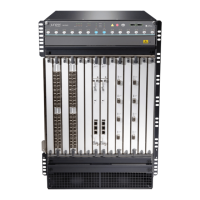4
Service Flexibility—Juniper is an industry leader in both MPLS
and VPLS, and the MX Series 3D Universal Edge Routers leverage
Junos OS, which is deployed in the leading services providers and
Fortune 500 enterprise worldwide. Junos OS provides the MX
Series feature richness, stability and service breadth not typically
found in Ethernet platforms.
Advanced Hierarchical QoS—the MX Series features superior QoS
across the platform, which enables service providers to ensure
that applications and services receive the appropriate level of
service regardless of traffic conditions. Hierarchical QoS enables
traffic shaping at the port, shaping and scheduling among a group
of VLANs, and priority-based scheduling at the queue level.
High Availability—the MX Series delivers the full Junos OS
continuous systems advantage, ensuring non-stop operations
and maximum uptime. As the only carrier Ethernet platform that
supports Unified ISSU, the MX Series can be upgraded with new
Junos OS features and versions with minimal risk or downtime.
The MX Series also provide features such as Graceful Routing
Engine Switchover (GRES), and Non-Stop Active Routing (NSR),
to provide rapid recovery and network convergence in the event of
link or node failures.
Service Protection— detecting failures in the network and
rerouting traffic around failures while honoring the SLA
requirements with end users. Some of the features available on
the MX Series for service protection include: MPLS link, node,
path protection; granular BFD hellos (10 msecs) for link failure
detection; Ethernet OAM (802.1AG, 802.3AH); ITU G.8032 for
Ethernet ring protection and SONET/SDH APS. A combination of
these features can be used to provide local or end-end service
protection of services configured on the MX Series.
Simplified Management—leveraging Junos OS tools such as
J-Web and Junos Script, the MX Series reduces the time and
expense of provisioning new services. The Commit Scripts feature
provides automated rollback capabilities that virtually eliminate
the possibility of downtime based on human configuration errors.
With the J-Web web-based GUI, the MX Series provides users with
simple to use tools to administer and manage routers.
The MX Series Extends Junos OS in the Network
Junos OS is a world-class operating system with proven stability
coupled with industrial-strength routing protocols, flexible policy
language and leading MPLS implementation. When building your
Ethernet-centric infrastructure, Junos OS can be a tremendous
asset as a flexible and reliable operating system.
Junos OS runs on Juniper Networks MX Series 3D Universal Edge
Routers, M Series Multiservice Edge Routers, T Series Core Routers,
as well as EX Series Ethernet Switches, J Series Services Routers
and SRX Series Services Gateways. Junos OS—the first routing
operating system developed specifically for the Internet—is
especially designed for large production networks. With native
support for both IPv4 and IPv6, as well as advanced interworking
capabilities, Junos OS also eases the transition to IPv6, and
ensures long-term investment protection.
Junos OS offers XML interfaces for advanced scripting capabilities,
and has been designed to configure the routing protocols that
run on the MX Series and the properties of its interfaces. After a
software configuration is activated, Junos OS has been designed to
monitor the protocol traffic passing through the MX Series, as well
as troubleshooting protocol and network connectivity problems.
Virtual Chassis Technology*
Virtual Chassis technology allows up to eight interconnected
physical chassis to be monitored and managed as a single
logical device. Virtual Chassis offers the following benefits:
• Simplifies manageability by providing a unified control plane
for all physical chassis
• Improves resource utilization by intelligently employing
interfaces and service line cards on physically dierent chassis,
providing customers with a “pay-as-you-grow” model.
• Protects user sessions across physical chassis, line card
or port failure, using stateful redundancy so users are
completely unaware of failures.
• Supports sophisticated resiliency techniques within the
Virtual Chassis.
MX Series VPNs
Junos OS supports of the industry’s richest portfolio of VPNs:.
• MPLS Layer 2 VPNs—the MX Series offers full support for both
LDP and BGP-based Virtual Private LAN Services (VPLS), as
well as LDP and BGP based pseudowires. With support for up
to 1 million MAC addresses and 64,000 VLANs, the MX Series
delivers industry-leading scale for Layer 2 VPNs.
• MPLS Layer 3 VPNs—with support for all types of IPv4 VPNs, as
well as IPV6 VPNs such as 6PE and 6VPE, the MX Series expands
the range of services carriers can offer customers. The MX Series
supports VPNs with advanced, application-layer features such
as Session Border Controller, Dynamic Application Awareness,
Intrusion Prevention System and Stateful Firewall Services.
• Carrier-of-Carrier VPNs—the MX Series allows a VPN service
provider to supply VPN service to a customer who is also a
service provider. The latter service provider supplies Internet or
VPN service to the end customer.
• Interprovider VPNs—Juniper supports standards-based
Interprovider VPNs, enabling customers to supply connectivity
between two VPNs in separate autonomous systems (ASs). This
functionality could be used by a VPN customer with connections
to several Internet service providers (ISPs), or different
connections to the same ISP in various geographic regions.
• Virtual router-based VPNs—with the virtualization capabilities
in Junos OS, the MX Series can be divided into multiple virtual
or logical routing instances, each supporting an individual VPN.
This opens up new possibilities for VPN services or enterprise
network segmentation.
*Note: Product roadmap.

